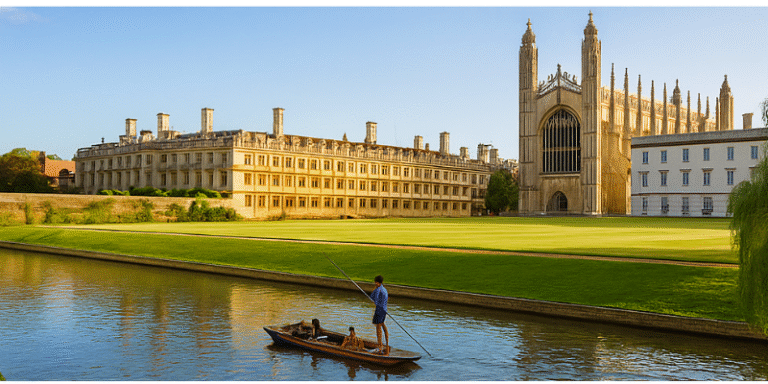Cambridge, in the county of Cambridgeshire in eastern England, is a city steeped in heritage, scholarship, and timeless beauty. With origins stretching back to the 12th century (University of Cambridge founded in 1209), it remains one of the world’s most celebrated centres of learning (Wikipedia, 2025). The architectural grandeur along The Backs, the cluster of colleges, and the gentle River Cam weaving through central streets provide a visual feast (The Student Room, 2024).
Historical and Cultural Appeal
The University of Cambridge, whose colleges such as King’s, Trinity, and St John’s boast iconic buildings like King’s College Chapel and the Mathematical Bridge, continues to attract scholars and tourists alike (The Times, 2024a). Visitors can enjoy guided tours, often led by university docents or alumni, offering rich insight into centuries of tradition and architecture (The Times, 2024a; TripAdvisor, 2024).
The city’s museums — notably the Fitzwilliam Museum, Museum of Zoology, and the Scott Polar Research Institute with its Polar Museum — offer free educational experiences spanning antiquities, natural history and exploration (The Times, 2024b; Travel Magazine, 2021).
When to Visit
Late spring (May or June) or autumn offers a more relaxed experience, with mild weather, vibrant foliage, and fewer crowds than summer peaks (The Sun, 2025a; The Times, 2024b).
Slow Tourism and Immersion
Cambridge exemplifies slow tourism, encouraging visitors to linger, explore at a gentle pace, engage with local culture and food, and savour authentic experiences rather than rushing through checklists (Oh, Assaf and Baloglu, 2014; Wikipedia, 2025b).
On The River Cam: Punting and Kayaking
A quintessentially Cambridge activity is punting: this serene river experience allows views of historic bridges and college facades. However, self-punting during high summer can be chaotic, especially for inexperienced punters (locals often recommend guided tours) (The Sun, 2025a).
For a more peaceful alternative, many opt to rent kayaks or canoes upstream – for instance from Scudamore’s Boatyard – and paddle towards Grantchester Meadows, enjoying scenery, wildlife and possibly a riverside picnic at dawn or a late afternoon break (The Sun, 2025a; The Times, 2024b).
Hidden Lanes and Local Gems
Rather than congested thoroughfares like King’s Parade, explore quieter passageways such as St Edward’s Passage, a Y-shaped medieval alley lined with independent bookshops, churches and historic architecture (Wikipedia, 2025c).
On Mill Road, away from the tourist centre, there is a vibrant multicultural strip of restaurants, vintage shops and neighbourhood pubs, offering a more authentic local experience (The Times, 2024a; The Sun, 2025a).
Parks, Green Spaces and Festivals
Open spaces such as Jesus Green, Parker’s Piece, Midsummer Common, Coe Fen and Sheep’s Green are perfect for strolling, cycling or simply relaxing among nature (The Times, 2024b; Wikipedia, 2025d). Parker’s Piece even hosted the early codification of association football rules.
Annual events, such as the medieval Midsummer Fair (first chartered in 1211) and the lively Strawberry Fair, bring colour and spectacle to the city (Wikipedia, 2025d).
Dining, Pubs and Nightlife
Cambridge’s pub-culture blends history, science and conviviality. The Eagle Tavern is famed as the place where Watson and Crick announced the discovery of DNA, its ceiling marked with graffiti from WWII airmen (The Sun, 2025a; The Times, 2024a). Other recommendations include the centuries-old Pickerel Inn, the Punter, Castle Inn, Carpenters Arms, Maypole, Brewhouse, and The Pint Shop (The Sun, 2025a).
For atmosphere and local charm, Mill Road’s cafés and eateries serve Lebanese, Syrian, Korean, Spanish, Japanese, Indian and Italian dishes. Long-standing cafés include Fitzbillies, beloved for its Chelsea buns, and Midsummer House, a Michelin-starred fine-dining destination (The Times, 2024b).
Nightlife in the city centre can be student-dominated, but locals tend to favour venues like Town & Gown, 2648, Ta Bouche, Lola’s, Mash, Vinyl and Revolution, found around Market Passage and Mill Road, offering cocktails, live music, and convivial gatherings (The Sun, 2025a; The Times, 2024a).
Tourism Impacts and Heritage Preservation
As a major heritage tourism destination, Cambridge benefits economically from millions of visitors each year, with tourism revenues estimated at over £750 million (Wikipedia, 2025a).
However, such popularity brings challenges: congestion, pressure on historic sites, rising prices and seasonal fluctuations affecting local life (Butler, 1980; Shepherd, 2002; Hakeem, 2018). Studies suggest Cambridge has largely managed these issues effectively, maintaining its cultural identity, architectural integrity, and community balance between locals and tourism (Hakeem, 2018).
A Traveller’s Recommendations
- Choose shoulder seasons (late May/June or early autumn) for fewer crowds and pleasant weather.
- Take a guided college tour to access hidden histories and architecture.
- Try slow tourism: stroll alleys like St Edward’s Passage, browse Mill Road shops, and linger in green spaces.
- Enjoy the river: opt for paddle-route upstream to Grantchester rather than busy punting in summer.
- Dine locally: seek out family-run cafés, ethnic eateries on Mill Road, or historic pubs like the Eagle.
- Respect heritage impact: follow routes that ease footfall pressure, support community-led events, and choose local experiences over mass-market tourism.
General Itinerary for Visiting Cambridge
| Activity | Description |
| Explore Historic Colleges and Architecture
|
● Take a guided walking tour of the University of Cambridge to see famous colleges such as King’s, Trinity, and St John’s.
● Visit King’s College Chapel for its stunning Gothic architecture. ● Stroll along The Backs for picturesque views of the colleges and gardens. |
| Enjoy the River Cam | ● Go punting for a classic Cambridge experience, with a guided tour or self-hire.
● For a quieter experience, rent a kayak or canoe and head towards Grantchester Meadows for scenic river views. |
| Visit Museums and Cultural Attractions | ● Explore the Fitzwilliam Museum for art and antiquities.
● Visit the Museum of Zoology or Scott Polar Research Institute for science and exploration history. |
| Wander Hidden Streets and Local Neighbourhoods | ● Discover St Edward’s Passage with its bookshops and historic charm.
● Explore Mill Road for multicultural restaurants, vintage shops, and a local atmosphere. |
| Relax in Parks and Green Spaces | ● Spend time at Parker’s Piece, Jesus Green, Midsummer Common, Coe Fen, or Sheep’s Green.
● Enjoy walking, cycling, or picnicking in these open spaces. |
| Experience Cambridge’s Food and Drink Scene | ● Try Fitzbillies for its famous Chelsea buns.
● Enjoy fine dining at Midsummer House or sample hearty meals at pubs like The Eagle, The Punter, or The Pickerel Inn. |
| Take Part in Local Events | If visiting in summer, attend the Midsummer Fair or the Strawberry Fair for a lively cultural experience. |
Visiting Cambridge is more than a trip — it’s a cultural journey through time, where collegiate splendour, leafy commons, historic pubs and river life blend with the gentle pace of slow tourism. While rooted in scholarship, the city belongs as much to walkers lingering in cobbled lanes, diners savouring local flavours, and visitors seeking a genuine, unhurried connection to place. Whether sampling Midsummer Fair, punting at dawn or enjoying a Chelsea bun in Fitzbillies, Cambridge invites you to pause, discover, and be charmed.
References
Butler, R.W. (1980) ‘The concept of a tourist area cycle of evolution: implications for management of resources’, The Canadian Geographer, 24(1), pp. 5–12.
Hakeem, S.M.A. (2018) ‘The perspective on tourism impacts in Cambridge, United Kingdom’, Marketing and Management of Innovations, 9(3), pp. 240–250.
Oh, H., Assaf, A.G. and Baloglu, S. (2014) ‘Motivations and goals of slow tourism’, Journal of Travel Research, 53(5), pp. 205–219.
Shepherd, R. (2002) ‘Commodification, culture and tourism’, Tourist Studies, 2(2), pp. 183–201.
The Student Room (2024) Cambridge: visiting tips. Available at: https://www.thestudentroom.co.uk (Accessed: 4 August 2025).
The Sun (2025a) The charming UK city where tourists visit for its world-class university. Available at: https://www.thesun.co.uk/travel (Accessed: 4 August 2025).
The Times (2024a) Cambridge travel guide. Available at: https://www.thetimes.co.uk (Accessed: 4 August 2025).
The Times (2024b) Best things to do in Cambridge. Available at: https://www.thetimes.co.uk (Accessed: 4 August 2025).
Travel Magazine (2021) Oxford vs Cambridge: a tourist’s perspective. Available at: https://www.travelmagazine.com (Accessed: 4 August 2025).
TripAdvisor (2024) Help with Cambridge University tour. Available at: https://www.tripadvisor.co.uk (Accessed: 4 August 2025).
Wikipedia (2025a) Cambridge. Available at: https://en.wikipedia.org/wiki/Cambridge (Accessed: 4 August 2025).
Wikipedia (2025b) Slow tourism. Available at: https://en.wikipedia.org/wiki/Slow_tourism (Accessed: 4 August 2025).
Wikipedia (2025c) St Edward’s Passage. Available at: https://en.wikipedia.org/wiki/St_Edward%27s_Passage (Accessed: 4 August 2025).
Wikipedia (2025d) Midsummer Common. Available at: https://en.wikipedia.org/wiki/Midsummer_Common (Accessed: 4 August 2025).













